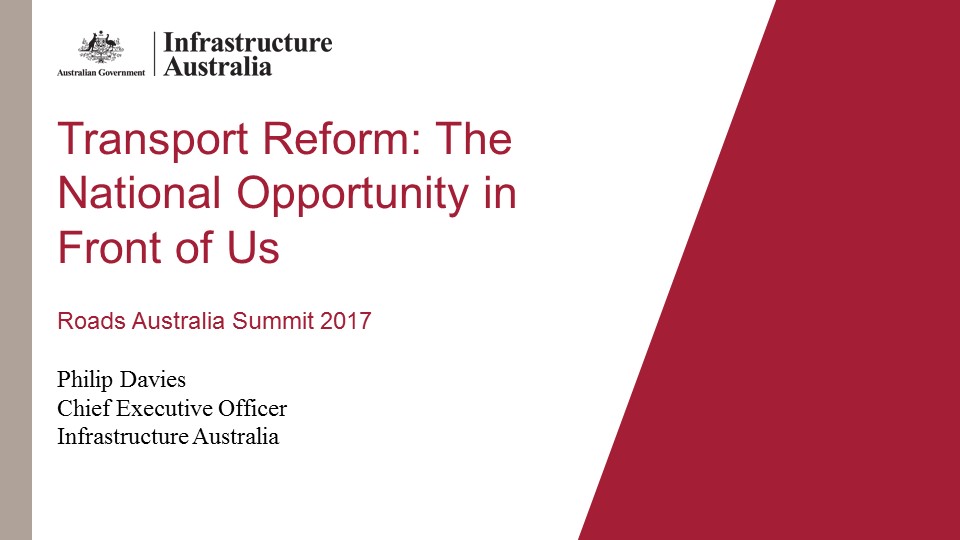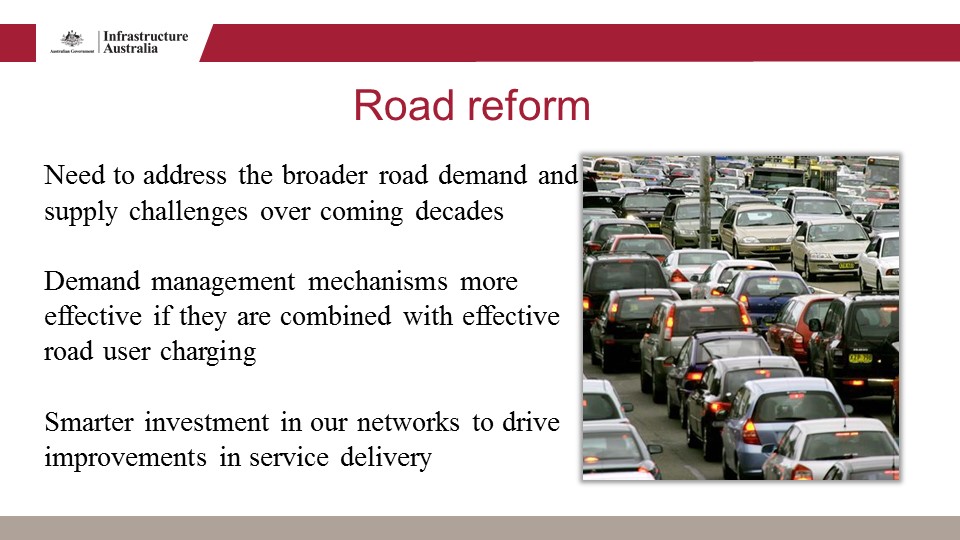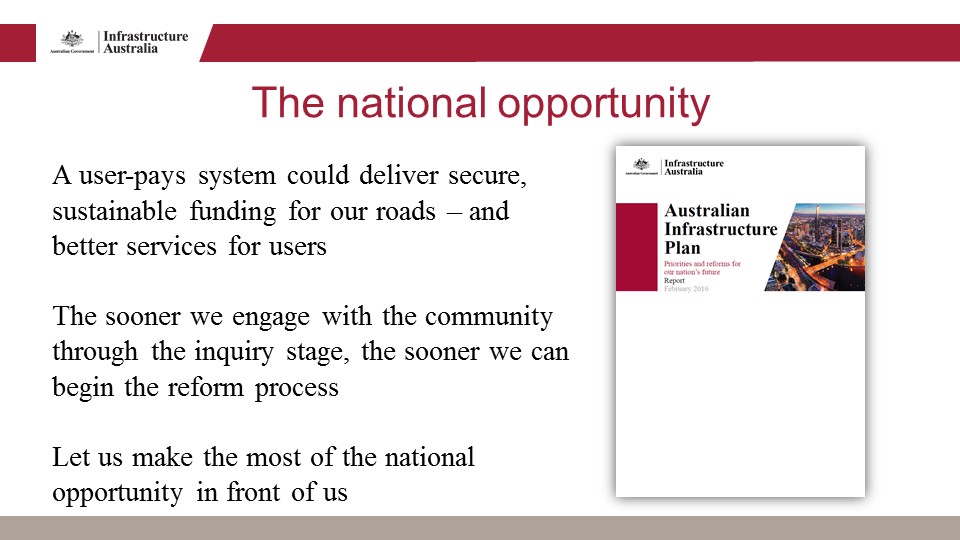
Transport reform: the national opportunity in front of us
1 June 2017

- Good morning ladies and gentlemen. It’s a pleasure to be here this morning at the Roads Australia Summit.
- I would like to thank Roads Australia for the very kind invitation to take part in this year’s event.
- Road reform is a critical issue affecting Australians in every state and territory.
- At IA we believe that we have a national opportunity in front of us to improve the way Australian governments fund infrastructure investment in our roads and address significant constraints on the economic growth and productivity of our urban centres.
- It is for this reason that Infrastructure Australia’s has placed significant emphasis on road reform in our Plan.
- Infrastructure Australia released our revised IPL in February this year. We maintain the IPL to help Australian governments make authoritative, integrated decisions and invest in projects that best meet our future infrastructure needs.
- The IPL features a number of nationally significant road projects including the Northern Road Upgrade in the Western Sydney Priority Growth Area, and the progressive upgrade of the Bruce Highway in Queensland.
- Investing in new nationally significant infrastructure will go a long way to addressing network constraints and providing additional capacity.
- However we also need to make better use of existing infrastructure.
- In particular, we need to ensure that existing infrastructure is used more efficiently, with a focus on maintenance and the use of new technology, including sensors and data analytics, to secure service improvements and meet customer needs.
- In the Plan, we propose these kinds of targeted investments as part of a broader program of network optimisation.
- Embedding technology in existing infrastructure can provide operators with rich data on network performance and use, which in turn drives improvements in efficiency and reliability.
- But in order to pay for optimisation of our road networks and invest in new infrastructure, Australian government’s urgently need to diversify their available pool of funding.

Technological change and funding
- With budgets constrained and fuel excise revenue declining, it is more important than ever to implement a change to the current system of road funding.
- Advances in technology solidify this case. It is no longer a question of if fuel efficient, electric and driverless vehicles will become the norm, but how soon will it happen.
- With Australia’s four largest cities—Melbourne, Sydney, Brisbane and Perth—expected to double in population in the next 15 years, we should be embracing these kinds of innovative technologies that improve the liveability of our cities.
- But before we accept broad uptake of fuel efficient, electric and driverless vehicles we must implement a fairer, more efficient and sustainable funding model to continue building and maintaining our roads.
- Since its introduction over 100 years ago, fuel excise has been an effective way of paying for roads. However, today fuel excise raises less than half of what Australian governments of all levels spend on roads.
- The shift towards driverless, electric and fuel efficient vehicles means this fall in revenue will accelerate over coming decades. This means that governments will effectively be collecting less revenue from users while the costs to build and maintain the roads continues to grow.
- When the main mode of transport was the horse and cart, the government of the time had the foresight to implement fuel excise.
- We need to channel that foresight today.
- Unless we progress road reform as part of a broader commitment to deliver our infrastructure through well-structured, well-regulated markets Australian governments will face a serious funding cliff.

The case for user pays
- A key priority for Australian governments then must be to find equitable and sustainable ways to fund infrastructure investment.
- A central theme in the Australian Infrastructure Plan is that we need to diversify the sources of funding.
- And that involves implementing user charging where possible to fund the development, maintenance and operation of infrastructure assets.
- Experience shows that where there is a direct link between usage and supply, infrastructure services are more efficient, responsive to consumer demands and financially sustainable.
- Australia’s road networks have comparatively weak links between usage and charging, with the notable exception of urban toll roads.
- Urban toll roads are typically well maintained and responsive to drivers’ needs, whereas local roads are underfunded, congested and less efficient at getting people from A to B.
- In these cases, the absence of user pays means the taxpayer remains directly involved in funding new road infrastructure across inception, planning, delivery and operations.

Road reform
- Clearly, a funding shortfall is a growing problem for Australia’s governments. But road reform must also address the broader challenges for our roads over coming decades, across road demand and supply.
- On the demand side, we must address the growing congestion in our cities, and improve road network efficiency to support a growing, productive economy.
- As we have shown in our Audit and Plan, our cities are increasingly the primary sources of growth in the broader Australian economy.
- Without action, we run the risk of allowing congestion to stifle some of this growth, constraining the productivity of our workforce, and reducing our global competitiveness.
- While great advances in Intelligent Transport Systems (ITS) are allowing road operators to extract greater efficiency from our roads, demand management mechanisms can be far more effective if they are combined with fair and effective pricing of road use.
- By providing point-of-use pricing for road users, combined with network monitoring of not just roads but broader transport options, it will be possible to revolutionise how users plan and select their travel.
- By putting this information, combined with price signals, at users’ fingertips, operators can greatly improve the efficiency of whole transport networks.
- On the supply side, we need to reform how we manage networks, using data and analytics capabilities we have never had before, to allow users to receive a good level of service more affordably. This will require smarter investment in our networks, across capital, operational and maintenance expenditure.
- Importantly, this will require changes across all levels of government, from how revenues are collected and dispersed among agencies, to how road budgets are allocated and contracts are managed.

Need for a comprehensive road pricing solution
- There are a range of potential solutions to our road challenges. There is clear merit in exploring these in detail, it is also clear that some approaches will not meet all our needs.
- We often hear calls for a congestion charge in our major urban centres, similar to those introduced in other global cities like London and Singapore.
- While a congestion or cordon charge could help to address some of the worst traffic problems in our largest cities, it would not provide a fair or sustainable means of raising the revenue governments require to build, operate and maintain our road network into the future.
- IA’s view is that we need a comprehensive road pricing solution, where all road users—across light and heavy vehicles— pay a fair price for their use of the roads.
- A whole-of-network solution could provide sustainable funding for our roads while effectively managing demand on congested roads in our cities.

Consideration of regional and vulnerable users
- Of course, Australia is a vast country. A one-size-fits-all approach to our roads is unlikely to meet the needs of all users.
- Roads provide a lifeline in many parts of the country. Without roads, many Australians would lack access to jobs, services or community facilities. And in many cases, these services can be vast distances away.
- It is understandable that vulnerable users are fearful that changing how road use is paid for will leave them worse-off.
- That’s why one of the first considerations in the road reform pathway should be how changes in road user charging are likely to impact users in regional areas, on the fringes of our cities, lower income earners, and others who rely heavily on the roads.
- Policy makers have a clear responsibility to respect and address the concerns of all road users. Engaging early and often with vulnerable users will be essential to provide confidence to the community that road reform can and will deliver fair and equitable outcomes for all Australians.

Public inquiry
- This is no small undertaking. But reform won’t happen in a backroom in Canberra. The problems we face today need to be shared with the public.
- The Government’s commitment to an independent study in response to the Australian Infrastructure Plan on the potential benefits and impacts of road market reform is an important first step, and an excellent opportunity to build consensus within government, industry and the community.
- Although most of us who work in infrastructure understand that a user-pays approach can deliver better services for users, there must also be deep public consultation to gain community support for a new approach to paying for our roads.
- Events like these provide a great platform for these issues to be discussed at length, but we can’t operate in an echo chamber. The public need to be made aware of our challenges.
- Without a full awareness of funding challenges we face, we cannot expect the broader community to support the reform changes we propose.
- The inquiry needs to engage directly with communities and lead public debate, to raise awareness of how we pay for roads and why this is unsustainable and unfair.
- By demonstrating the costs of inaction we can create a compelling case for reform.
- Early and meaningful engagement with the community—where there is a genuine opportunity for public deliberation—will ensure that we don’t have issues down the road that result in considerable costs and delays.
- We acknowledge that any inquiry and resultant reform process is likely to take several years at a minimum.
- Keeping up the momentum for reform then must be a key priority and joint responsibility of government and industry.

Concluding remarks
- The task ahead of us is clear. We need to transition to a fairer user pays approach that would allow charging to be linked to funding and supply to be linked to demand.
- Unlike the current approach where taxes and charges are allocated to various government spending priorities—both in transport and other areas, this revenue would be reinvested back into the transport network.
- A user-pays system of road funding could deliver secure, sustainable funding for our roads—and better services for users—but we need to get on the front foot and begin planning for this level of change sooner rather than later.
- While the pathway to reform is likely to stretch over the next decade, it must start now if we are to deliver improvements in network performance, address fairness issues and provide a sustainable source of funding for our road networks.
- The sooner we engage with the community through the inquiry stage, the sooner we can begin the reform process.
- With the right public engagement, we can beat a path forward to make the most of the national opportunity in front of us.
- We look forward to making our contribution to process and working with Roads Australia to progress this important reform.
- Thank you.